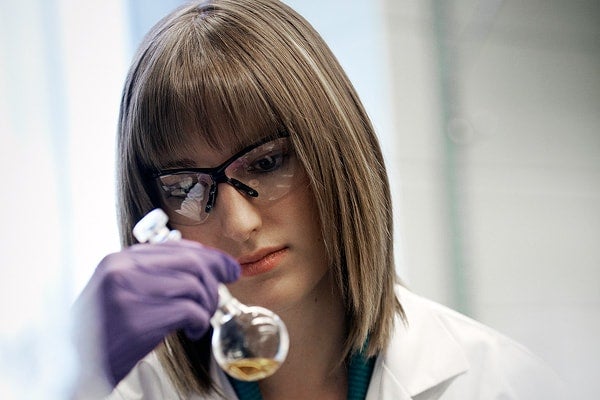
Meet doctoral student Melanie Mastronardi
Published: February 27, 2013
Graduate student Melanie Mastronardi of the Department of Chemistry is the first recipient of the Natural Sciences and Engineering Council's newly established Gilles Brassard Doctoral Prize for Interdisciplinary Research.
Mastronardi is working to make nanotechnology more environmentally friendly so that when the technology is adopted for wider use, it will have a smaller environmental footprint.
Already used in LED devices, nanocrystals or quantum dots are seen as essential in quantum computing and show promise in biomedical applications such as drug delivery and treatment of tumours, and in improving efficiencies in solar energy. However, today's nanocrystals are made mainly from heavy metals; Mastronardi is exploring "greener" and less expensive options.
U of T News asked Mastronardi to discuss her work and its implications for future generations.
Tell us about your research.
The field that I work in is called nanochemistry. It is a relatively new area of research and involves the study of materials that are on the scale of 1-100 nanometers in size (1 nm is about 20,000 times smaller than the width of a human hair).
Other than the size range, it is hard to put a specific label on the science that I do as it encompasses a wide variety of disciplines including organic, inorganic, physical and analytical chemistry. The material that I work on specifically is silicon nanocrystals, which are essentially spheres of crystalline silicon that are covered with organic ligand molecules that are grafted to the silicon surface. The silicon nanocrystals typically range from 1-8 nm in diameter, and are soluble in various organic solvents. Bulk silicon does not have any emissive properties, but when you get in the nanoscale size range these materials start to emit light which varies in colour as the size of the nanoparticles changes.
Other nanocrystals made of metals show similar properties, but silicon is an ideal material because it is earth abundant and considered to be much less toxic that the heavy metals typically used like lead and cadmium.
My research, in particular, involves synthesizing silicon nanocrystals and separating the different sized particles that form so that I can study the different properties of each size.
What kind of impact could this research have for society?
Ideally, we hope the information I learn from studying the size-dependent properties of silicon nanocrystals can be used to tailor these materials to achieve high light emitting efficiencies and properties that will allow the commercialization of silicon nanocrystal light emitting diodes (LEDs) or biological applications.
There are a lot of applications being developed that use heavy metal-containing nanocrystals for LED displays, therapeutic treatments or biological imaging, but the availability, cost and toxicity of these materials are a concern. If silicon nanocrystals can be developed to stand up to these materials in terms of efficiency and stability, then they may be a cheaper, abundant and less toxic alternative.
What drew you to this field – and to this particular focus?
Before starting my graduate work I had very little knowledge of nanochemistry and didn’t know what specific area of research I wanted to pursue. I met with professors in a variety of disciplines including environmental, inorganic, and materials chemistry. I ended up choosing nanochemistry because I was drawn to this particular project and the enthusiasm my research supervisor Professor Geoffrey Ozin has for scientific research.
I was particularly fascinated by the colours of the silicon nanocrystals, which emit light ranging from red to blue, and the idea of working towards a concrete final product or application that could one day be of great use to society.
Why U of T?
I have always been involved in the arts as a dancer and performer, and I knew that I wanted to live in a city where I would have the opportunity to get involved in artistic projects while pursuing graduate studies. Since Toronto has an amazing arts community and U of T has a great reputation for its research programs, it seemed like a perfect fit. U of T was the only place I applied to and it was definitely one of the best decisions I ever made. I have had so many amazing experiences during the few years I’ve been here both as a scientist and a performer.
What advice would you give to a student just starting out in this field?
In any field, research can be a very daunting task, but particularly when studying nanochemistry, since it is a relatively new field, it can be very difficult to find all the information you need to know in one place. There are very few nanochemistry textbooks, and since the field encompasses so many different disciplines it would be hard to fit it all into one book, let alone learn it all.
My advice would be to make sure to join a group with a supervisor and colleagues you get along well with, who are both knowledgeable and willing to help each other out. Most of the things I’ve accomplished in my research have been with the support of my colleagues and collaborators.
One person can’t be an expert in everything, but if you surround yourself with good people and work together, there are probably very few problems that can’t be solved.



